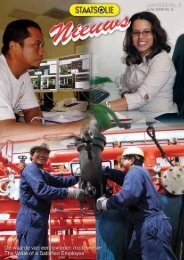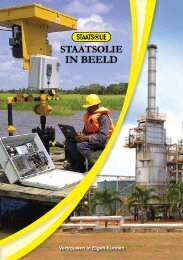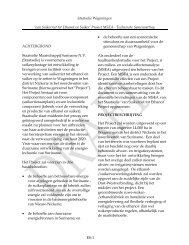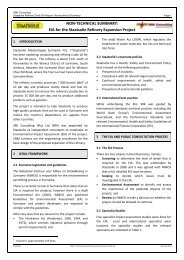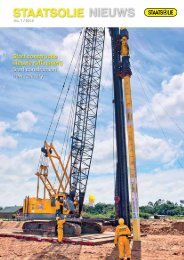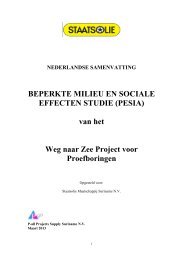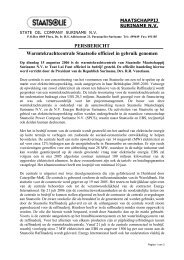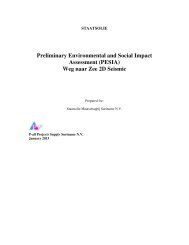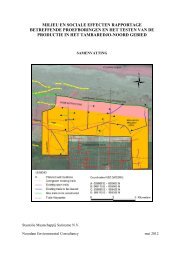(PESIA) Weg naar Zee 2D Seismic - Staatsolie
(PESIA) Weg naar Zee 2D Seismic - Staatsolie
(PESIA) Weg naar Zee 2D Seismic - Staatsolie
Create successful ePaper yourself
Turn your PDF publications into a flip-book with our unique Google optimized e-Paper software.
P-all consultants <strong>Staatsolie</strong> Maatschappij Suriname N.V.<br />
<strong>PESIA</strong> <strong>Weg</strong> <strong>naar</strong> <strong>Zee</strong> <strong>2D</strong> <strong>Seismic</strong> 2012<br />
area except for the ultimate southern part which passes nearby or crosses private lands with<br />
horticulture activities. The southern part of this line lies close to archaeological site 060.<br />
The ecosystems crossed are:<br />
- dying coastal mangrove forest: Black Mangrove (ST: Parwa; SC: Avicennia germinans)<br />
- salt / brackish water swamp dominated by short grass and ferns<br />
- thorny vine scrub, dominated by (ST: Brantimaka, SC: Machaerium lunatum)<br />
- coastal ridge wood on narrow ridges in brackish to fresh water areas<br />
- brackish water swamp dominated by long grass such as Cat Tails (ST: Payagrasi,<br />
Langagrasi or Kunsuwiwiri; SC: Typha domingensis)<br />
- freshwater swamp with herbaceous vegetation and swamp scrub<br />
- swamp wood dominated by Blood Wood (ST: Watrabebe; SC: Pterocarpus<br />
officinalis), locally swamp wood characterized by Swamp Plumb (SD: Zwamppruim; SN:<br />
Chrysobalanus icaco) and Swamp Soursop (ST: Swampusunsaka; SD: Zwampzuurzak;<br />
SC: Annona glabra).<br />
- build up areas, farmland and abandoned fields<br />
WNZ-<strong>2D</strong>-2011/004 (6.6 km). This line also runs in a South – North direction also in the western<br />
part of the <strong>Weg</strong> <strong>naar</strong> <strong>Zee</strong> area. The major part of this line also runs through uninhabited area<br />
except for the ultimate southern part which passes nearby or crosses private lands with<br />
horticulture activities. The southern part of this line lies close to archaeological site 022 as<br />
mentioned in Figure 9.<br />
The ecosystems it crosses are:<br />
- swamp wood dominated by Blood Wood (ST: Watrabebe; SC: Pterocarpus officinalis),<br />
locally swamp wood characterized by Swamp Plumb (SD: Zwamppruim; SN:<br />
Chrysobalanus icaco) and Swamp Soursop (ST: Swampusunsaka; SD: wampzuurzak;<br />
SC: Annona glabra)<br />
- coastal ridge wood on narrow ridges in brackish to fresh water areas<br />
- brackish water swamp dominated by long grass such as Cat Tails (ST: Payagrasi of<br />
Langagrasi or Kunsuwiwiri; SC: Typha domingensis)<br />
- thorny vine scrub, dominated by (ST: Brantimaka, SC: Machaerium lunatum)<br />
- freshwater swamp with herbaceous vegetation and swamp scrub<br />
- build up areas, farmland and abandoned fields<br />
WNZ-<strong>2D</strong>-2011/005 (6.0 km). This line runs in an East – West direction, crosses the Henri<br />
Fernandesweg and the canals at the both sides of this road and runs north and parallel to the<br />
inhabited Oedraysing Varma weg and the Brantimakkaweg. The part west of the Henri<br />
Fernandesweg runs through developed private owned lands and close to human settlements and<br />
their agricultural lands and also close to the Pilgrimage site <strong>Weg</strong> <strong>naar</strong> <strong>Zee</strong>. The eastern part (east<br />
of the Henri Fernandesweg) runs through mangrove forest, part of which is dying or already has<br />
died. The most eastern part of the line runs through the private owned lands of Mr. Graanoogst<br />
and Mr. Gummels where it crosses the WNZ-<strong>2D</strong>-2011/008 line.<br />
WNZ-<strong>2D</strong>-2011/006 (3.9 km). This line runs in a North-South direction and crosses the inhabited<br />
Brantimakaweg, the Ingipipaweg, the Parwaweg and the Kwepieweg along which people have<br />
64




